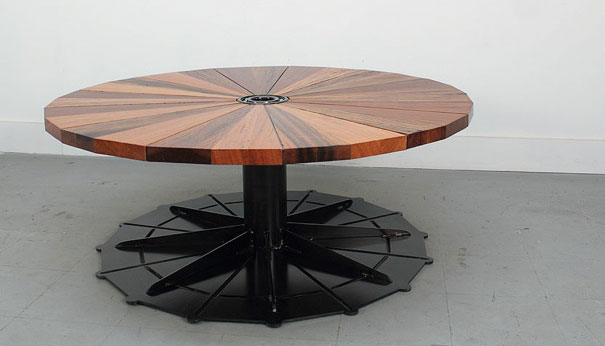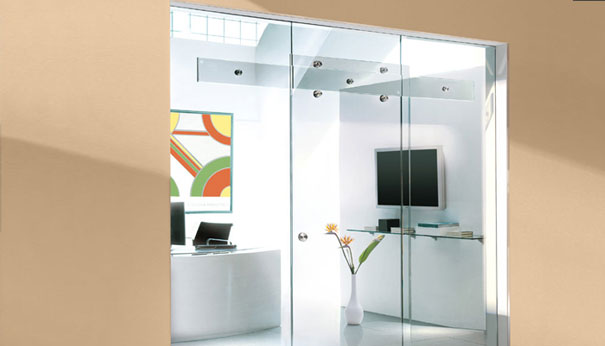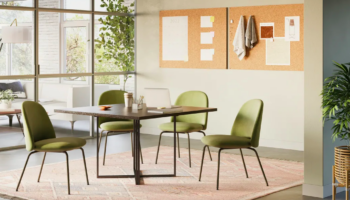At BKLYN Designs: The Deliciously Dilapidated Coney Island Line by Uhuru
What I remember most about visiting Coney Island in the 1990s is pain. Pain in the neck, to be precise. Although I detest rides of any kind–I just don’t think the body was designed for moving at such rates, the anatomy not meant to withstand such jostling–I agreed (foolishly, oh so foolishly) to ride the dreaded Cyclone. For those unfamiliar with this particular species of torture, the Cyclone is a wooden roller coaster built in 1927–still standing and still operating, despite all common sense and safety standards.
Cyclone Lounger. Designed by Uhuru.
Wood is not conducive to a smooth ride. I felt as if my spine would pop right out of its rightful place and travel up and out through the crown of my head. After I recovered (sort of recovered, my neck hurt for days), I strolled around Coney Island, thankful for my intact skeleton, and admiring the entire decrepitude of the resort area. I have particular fondness for structures in states of decay, a sort of anachronistic penchant for history’s phantasms.
As it turns out, I’m not the only one. Brooklyn-based furniture design company Uhuru, which is “dedicated to sustainability and local craftsmanship,” is showing their new collection of reclaimed wood furniture entitled Coney Island Line (it even alludes to the subway). The six pieces are “crafted from reclaimed Ipe wood from the demolished iconic New York boardwalk” and play with the famed peninsula’s best known shapes, objects, and landmarks, “whose early splendor now only exists in ghostly memories.” The Coney Island Line is featured in New York Magazine‘s current design issue and will be exhibited at BKLYN Designs from May 7-9. The Ipe wood hails from the 1940s, now having weathered the elements for 70 years–making it the perfect material to contain the powerful nostalgia of this peculiar geography. Given the “finite nature” of the salvaged wood, Uhuru‘s Coney Island Line is limited to 10 editions of each of the six pieces. As a whole, the collection depicts “the architecture of the desolate dreamscape: low-rise buildings patched with signs and seasonal layers of paint, beneath the towering old-fashioned rollercoaster.”
Wonder. Designed by Uhuru.
Boardwalk. Designed by Uhuru.
The signature piece in this collection is the Cyclone Lounger–after that horrid “amusement” I wrote about earlier. The white, laser-cut metal base recalls the roller coaster’s labyrinthine frame, a vast criss-cross of dizzying magnitude–like a giant cat’s cradle. The lounger’s curves interprets the Cyclone’s celebrated drops (one of which is 85 feet long at a 60 degree angle). The slats of wood that make up the surface summon the legendary boardwalk–although Uhuru offers another piece that pays tribute more directly, the Boardwalk Console. Using a chevron pattern, the slim slats of Ipe wood replicate the boardwalk’s original inlaid design–on a much smaller scale. Uhuru has even included miniature nail-heads. Another piece I particularly enjoy is the Wonder Coffee Table, which reminds me of long-dismantled circus tents, broken-down ferris wheels, and machine cogs in need of oiling. But Uhuru likens the shape to something else entirely: “a Vaudeville-inspired scalloped pattern.” Wonder Coffee Table looks like it could spin, spin, spin. It can even spin a yarn: Uhuru states it “could have been part of a ride itself: spinning on an open ball bearing.” Story, of course, underlies some of the best furniture design–and the Coney Island Line makes me want to inhabit this unlikely fairy tale space where knife throwers barely nick target girls with too dull knives and ghouls scarcely frighten passengers in the penumbrous dark of ramshackle haunted houses.






Leave a Reply